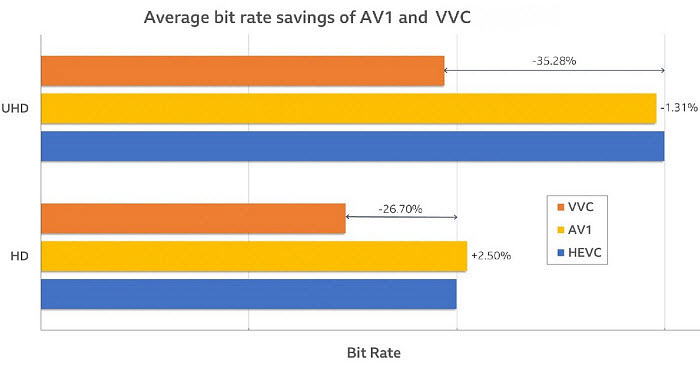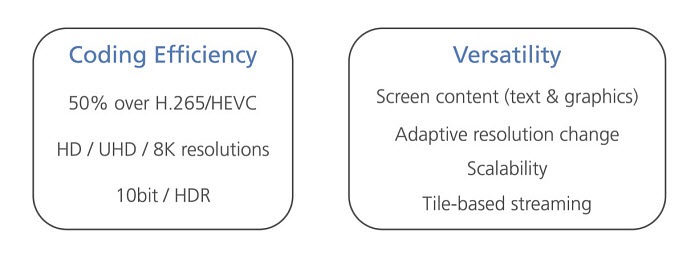H.266 VVC vs H.265 HEVC - 50% More Efficient Than H.265
With increasing growth of video streaming on the Internet over popular websites such as Netflix and YouTube, and with the increasingly higher resolutions used by cameras, a considerable amount of storage and bandwidth is required. HEVC/H.265 was introduced to reduce the data requirements. But now, a new video encoding standard named Versatile Video Coding (VVC), also known as MPEG-I Part 3 or H.266, is unveiled to further improve the coding efficiency by around 50 percent compared to H.265 HEVC. What's the difference between HEVC and its successor VVC?
Note: some data used in this article is from the Paper "VVC PER-TOOL PERFORMANCE EVALUATION COMPARED TO HEVC" by Edouard François, Michel Kerdranvat, Rémi Jullian, Christophe Chevance, Philippe De Lagrange, Fabrice Urban, Tangi Poirier, Ya Chen (InterDigital)
Content:
- 1. History
- 2. Compression Efficiency
- 3. Coding Performance
- 4. License
- 5. Technical Comparison
- 6. Adoption
1. History
H.264 AVC has been widely used among the internet, mobiles, HDTVs, computers, other storage, and transmission platforms for 18 Years. It supports resolutions from SD up to 4K (4096×2304). But with the explosive growth of 4K and higher resolutions, H.264 can’t always provide the efficiency we need. A new video coding standard with a higher compression ratio is needed to deal with the emerging multimedia applications.
10 years after the release of H.264, H.265 HEVC came out as the successor to h.264. HEVC is promising a massive 50% bandwidth reduction compared to H.264 for the same video quality. It's able to support UHD videos up to 8K at up to 120fps. Due to its complicated licensing and high demand for computing power, its adoption is quite slow.
What is VVC? Is it a revolutionary video coding standard? No, it's basically an evolution based on the technologies used in HEVC. In short, VVC H.266 is a step towards 8K and higher resolutions. Started in 2015, the JVC began to consider video coding standards with capabilities beyond HEVC. In 2020, Fraunhofer HHI (together with partners like Apple, Ericsson, Intel, Huawei, Microsoft, Qualcomm, and Sony).
2. Compression Efficiency
Compared to H.265 HEVC, H.266 VVC can reduce data requirements by around 50% of the bit rate without compromising visual quality. Specifically, BBC R&D found that VVC performed 27% better than HEVC for HD sequences and 35% for UHD sequences. Specially designed for 4K and 8K streaming, the data reduction will do a lot to help playback and streaming of 8K HDR video content on future TVs, smartphones, and other devices. After all, a typical 8K HDR movie could eat up anywhere from 6GB to 20GB per hour if you were watching it on Netflix today. Shrinking that figure down to one-half or one-fourth means more movies and fewer data caps to worry about.

VVC is supposed to support:
- Picture resolutions from 4K to 16K as well as 360° videos
- YCbCr color spaces with 4:2:0 sampling, 10-bit
- YCbCr/RGB 4:4:4 and YCbCr 4:2:2
- Auxiliary channels (transparency, depth, etc.)
- High dynamic range (HDR) and wide color gamut
- Bit depths up to 16 bits per component
- Fixed and variable frame rates
- Progressive scanning

3. Coding Performance
The higher compression efficiency of H.266 VVC comes with the trade-off of 10x or more encoding complexity compared to H.265 HEVC. Tests from VVC VTM reference software show that it’s up to 10x more complex to encode H.266 than H.265, and 1.7x more complex to decode. According to BBC R&D, encoding VVC takes 6.5x longer time than HEVC and its decoding is about 1.5x longer. Considering that HEVC is not very fast even with the right hardware, it’s a challenge to use H.266 on mobile devices or post-production before hardware manufacturers provide support to VVC.
4. License
Both HEVC and VVC are VVC is a royalty-bearing video codec. While HEVC with better compression over AVC, has been around for a while, we don’t see HEVC being implemented everywhere. This is because its licensing and royalty structure is too complex. How H.266/VVC will be licensed is not clear by now. But the new technology tries to avoid the same issue. It will be licensed via a uniform and transparent licensing model by the Media Coding Industry Forum (MC-IF), a group with 34 major member companies.
However, encumbered by patents, VVC is less impressive than AV1. The royalty-free AV1 is already used by companies like Netflix, Firefox, and Chrome. (Hot search: AV1 vs VVC, which is better for 4K & 8k?)
5. Technical Comparison
To achieve better compression efficiency, H.266 VVC has made several improvements in the compression algorithm compared to H.265 HEVC.
Tools |
HEVC |
VVC |
Partition size |
• Coding Unit: 8x8 to 64x64 |
• Coding Unit: 4x4 to 128x128 |
Partitioning |
• Transform: QT • Prediction: QTBT |
• QTBT + TT (NS, QT, BTx2, TTx2= 6 partitions) |
Intra Prediction |
• 35 predictors |
• 81 modes: 65 angular + planar + DC + Sub • 6-MPM • MRL, Matrix weighted pred |
Inter Prediction |
• 1/4 Pixel luma MV • 2 interpolation filters for MC |
• 1/16 Pixel luma MV • 2 interpolation filters for MC • DMVR (Decoder-side MV refinement) |
Transform |
• square DCT-based transforms • 1 DST4x4-based transform |
• DCT2 (up to 64x64) + MTS (<=32x32, DST7, DCT8, independent H/V) • Coefficient coding: HEVC + DQ design, sign hiding |
Entropy coding |
• CABAC |
• CABAC + dependent scalar quantization • LUT based CAE |
Loop filters |
• Deblocking • SAO |
Deblocking • SAO • ALF • LMCS |
6. Adoption
H.265 is used by most modern mobiles and 4K cameras, and almost all new hardware now provides HEVC GPU acceleration. H.266 VVC falls far behind in hardware and software support by far. No mobile SoC currently supports hardware-accelerated decoding or encoding in this new video coding format. And new chips are under development. We're unlikely to see H.266 codecs on smartphones and mainstream cameras until at least 2021. But once implemented, VVC could allow a stark reduction in traffic from services like Amazon Prime Video, Hulu, and Netflix.






















